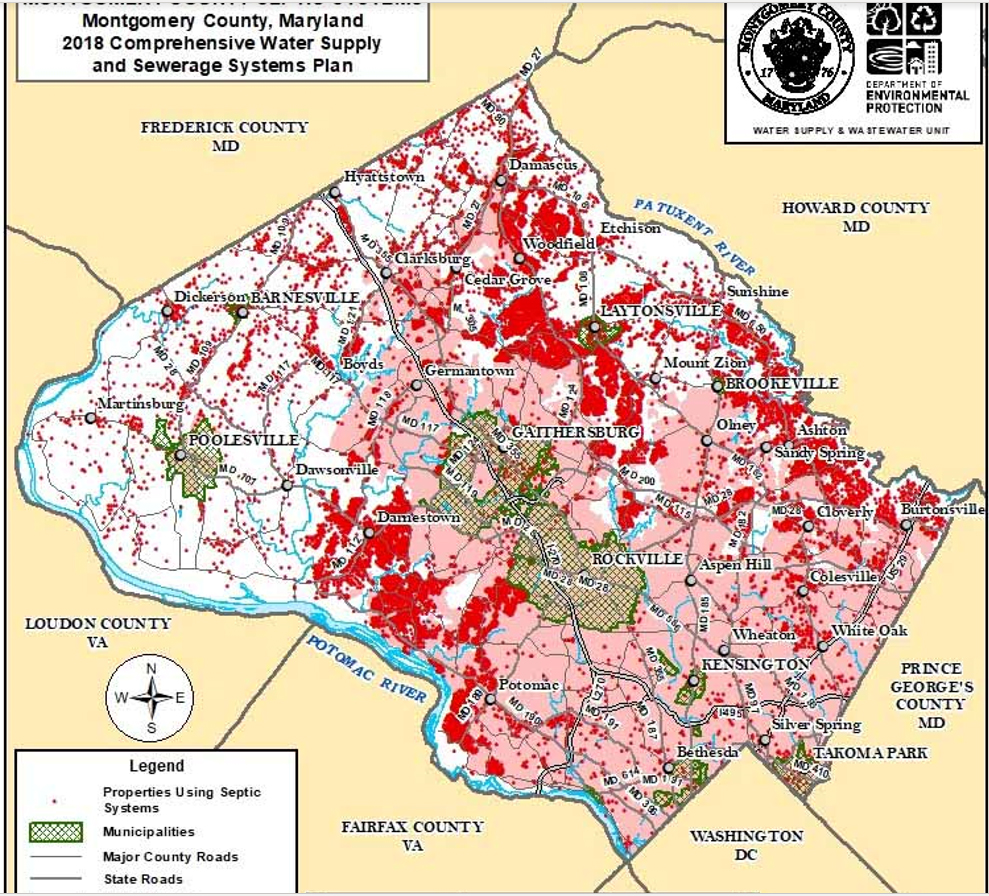Septic Systems
When your property uses a septic system for wastewater disposal, you become your own sanitary utility. You own and operate the facilities, maintain them, and must replace them when necessary. Your wastewater disposal system is the septic system buried under your yard. The septic system treats wastewater that flows from your home or business in two stages: the first is the septic tank that separates solids from liquids and the second, is an underground distribution system that disperses partially treated liquid effluent for final treatment as it percolates through the soil. The ability of a septic system to adequately and safely treat and dispose of sewage depends on the soil and rock conditions under your property and on how well you maintain and operate the system.
Types
A modern septic system includes two main parts. Wastewater from a building first enters the septic tank that separates wastewater solids and liquids. The liquid or effluent from the septic tank flows into the drainfield that discharges the effluent into the ground where aerobic bacteria in the soil provide further treatment. A contractor needs to pump wastewater solids out of the tank usually once every two to five years.
Septic Systems
A septic system typically includes a septic tank connected directly to your building. Current regulations require two-chamber septic tanks that hold up to twice the daily maximum expected flow from the user. The tank design allows sewage solids to separate from liquids and settle by gravity to the bottom of the tank. Every two to five years, a contractor needs to remove the solids from the tank, a process referred to as “pumping the tank” or “pumping the septic system.”
Until late 2016, the State had required all new and replacement septic tanks to utilize Best Available Technology (BAT) to promote better removal of nitrogen from wastewater. Reducing nitrogen from wastewater benefits environmental restoration efforts for the Chesapeake Bay and its tributaries. This requirement subsequently was removed from areas of the state located outside of Chesapeake Bay and Atlantic coast critical areas. Montgomery County does not include any state-designated critical areas. Local permitting authorities such as the County’s Department of Permitting Services (DPS) retain the discretion to require BAT septic systems on a case-by-case basis.
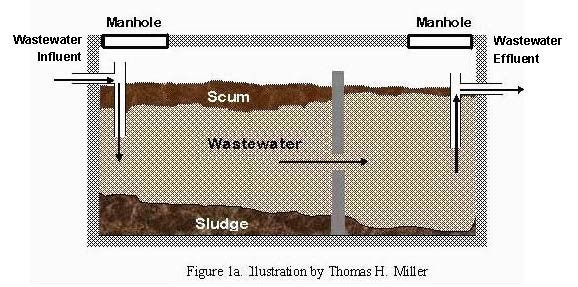 Two-Cell Septic Tank Cross-Section (Source: Thomas H. Miller, MCES)
Two-Cell Septic Tank Cross-Section (Source: Thomas H. Miller, MCES)Drainfields
The liquid from the upper level of the septic tank flows into an underground drainfield—a network of gravel and sand-filled trenches that use pipes to distribute the effluent across a broad area into the ground. Bacteria in the soil below the drainfield provide the final step in the treatment process as the effluent percolates down through the soil and finally into the water table.
Most septic systems in use in the County are deep-trench systems, in which drainfield trenches about two feet deep are buried at least two feet under the soil surface.
Also in use are shallow-trench systems, also referred to as shallow tile systems. In these systems the side of the trenches are lined so that effluent only drains downward, not out side-to-side. A shallow trench system typically requires more initial and reserve area than a deep-trench system designed for the same capacity.
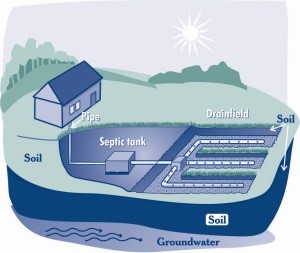 Septic System with Septic Tank and Drainfields (Source: Thomas H. Miller, MCES)
Septic System with Septic Tank and Drainfields (Source: Thomas H. Miller, MCES)An alternative to the deep- and shallow-trench systems is the sand-mound system, where a sand drainfield is artificially elevated above the natural soil surface to overcome a shallow water table or a marginal percolation rate in deeper soils.
 Sand Mound Septic System Cross-Section (Source: Glen Hills Area Sanitary Study (DEP), 2015)
Sand Mound Septic System Cross-Section (Source: Glen Hills Area Sanitary Study (DEP), 2015)
Other Effluent Discharge Features
One alternative or innovative type of septic system in use in the County is a shallow drip dosing system. These systems are installed just under the surface of the yard and pump effluent into a network of small pipes. The pipes have small holes that discharge the effluent into the soil. This type of alternative system is used only to relieve a failed septic system and cannot be used for construction of new buildings or expansion of existing buildings.
Older on-site systems use several varieties of discharge methods, such as seepage lagoons, dry wells, and seepage pits. These older systems may continue to serve only existing structures provided they continue to function adequately. Under the County's current on-site system regulations, new construction (a new structure or a significant expansion of an existing structure) may use only deep-trench or shallow-trench and sand-mound septic systems.
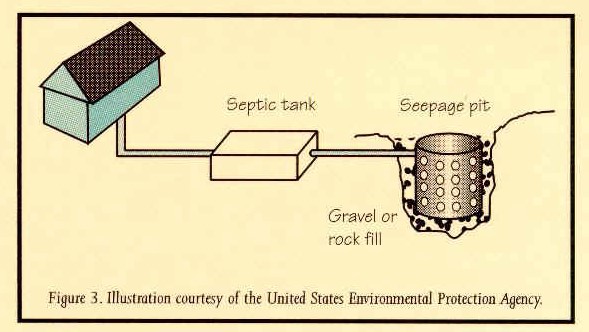 Septic System with Seepage Pit Discharge (Source: Glen Hills Area Sanitary Study (DEP), 2015)
Septic System with Seepage Pit Discharge (Source: Glen Hills Area Sanitary Study (DEP), 2015)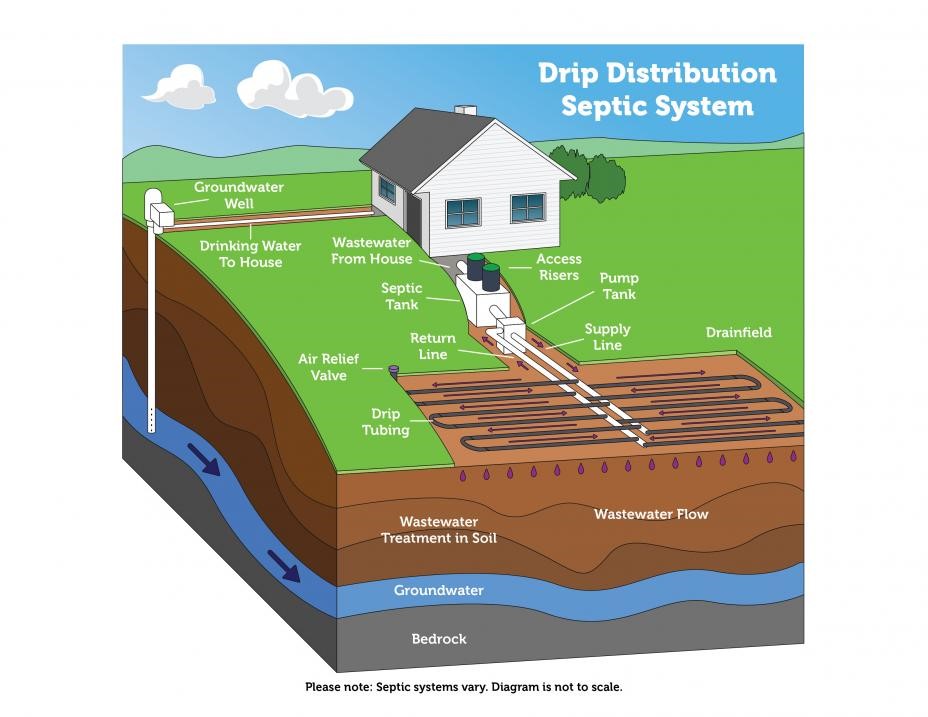 Shallow Drip Dosing Septic System (Source: U.S. EPA)
Shallow Drip Dosing Septic System (Source: U.S. EPA)Area Requirements for Septic Systems
Under current standards, a septic system for a new building lot must have an initial drainfield and enough area for three reserve or back-up drainfields. These back-up fields are built and put into service only as the drainfield currently in use fails. A typical single-family house needs an area of at least 10,000 square feet (slightly less than one-quarter acre) for the initial and reserve drainfields.
Properties in the Patuxent River watershed, with water supply reservoirs for the Washington Suburban Sanitary Commission, must reserve an additional 70 percent of treatment area. That means a single-family house that needs to reserve 10,000 square feet elsewhere in the County would need to set aside 17,000 square feet (slightly less than two-fifths acre) in the Patuxent River watershed.
Septic systems may not be located closer than 100 feet to any existing or proposed well. In addition, County onsite systems regulations establish other septic system setbacks for site features like steep slopes, stream buffers, and buildings.
Onsite Septic Systems Distribution in the County
The Department of Environmental Protection (DEP) estimates that approximately 20,000 properties in the county use an onsite septic systems for their wastewater disposal. (Approximately17,500 properties use an onsite well for drinking water supply.) Most of these onsite systems are found in large-lot residential and rural-zoned areas. As shown on the following map, areas served by onsite septic systems tend towards the western and northern parts of the county. However, numerous wells still serve properties within the existing public sewer service areas, including locations where public sewer mains are available for service.
Montgomery County Public Sewer Service Areas and Septic System Locations
